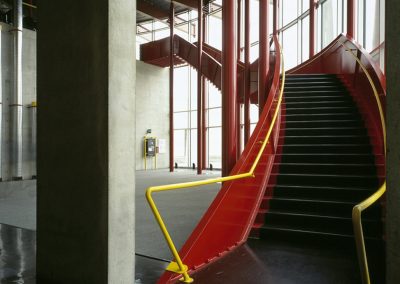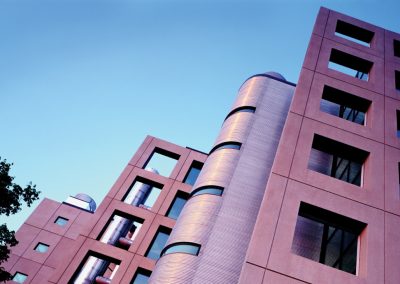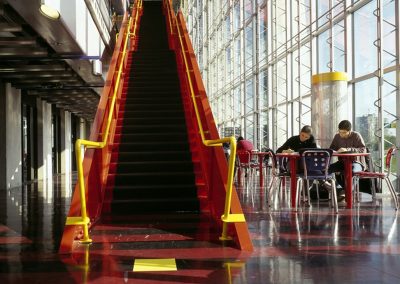University of Ottawa, ON
SITE’s mandate, beyond providing for the University of Ottawa’s growing spatial requirements, was to create a signature building that would act as an icon to the University and the School of Information Technology and Engineering. It would promote and market the University as a cutting-edge, progressive institution committed to providing students with the best education and facilities available anywhere in Canada. A significant challenge outside of the building program was the manner in which the new building would address the high-traffic Nicholas Transitway to the south, the Sandy Hill community to the north and the campus to the west.
The design solution communicated two expressly different façades in response to their respective urban dynamics. The Nicholas Street elevation makes use of its highly visible location to showcase a façade reminiscent of classical architecture, with monolithic tapered concrete columns supporting a “tiara”. To the north, SITE presents a rhythmic elevation of punched windows, creating a formal presence behind a glass rotunda, while its highly articulated west face to the campus expresses the highly technical nature of this special state of the art engineering facility. SITE has become the gateway to Ottawa’s downtown core, framing Parliament’s Peace Tower for visitors to Canada’s capital.
One of the most important objectives in the design of SITE was the incorporation of sustainable and energy-efficient design strategies that make it Canada’s most energy efficient operating at 14.5KW/day/year. SITE is a 175, 000ft2 ‘green’ facility utilizing state-of-the-art building technology. It is an evolution IKOY’s William Davis Facility constructed at the University of Waterloo in 1988 where principles of active thermal mass were applied to reduce heating and cooling loads.
The hollow core concrete floor is innovatively used to act as an air distribution network to save on unnecessary ductwork and to capitalize on potential heat transfer from circulated air. The elegant glass atrium of the building’s south face offers an outstanding view on the Rideau Canal while functioning as one of the largest inhabitable solar panels in the world. This facility clearly demonstrates that high tech state of the art design and sustainability can be combined into a building of architectural delight.
The facility features high technology computer laboratories and lecture theatres opening onto a fully glazed four storey galleria. The galleria and adjacent rotunda function together as a modern day ‘agora’, complete with a large cafeteria court, formal and informal lounges that interconnects the theatre level with the research suites and offices above. The exterior courtyard and plaza allow for large gatherings and provide both staff and students alike with relaxing outdoor spaces. The multi-level administrative floors are linked to the galleria where professors and students meet, interact and exchange ideas as they pass en route to classes, offices or other faculties and departments. There is also a 334 seat, 8,000ft2 electronic data library for research by students and faculty staff.
The project combines function and quality in a facility that elevates the human spirit. It was constructed within budget, exceeding the most stringent ‘green’ building requirements. SITE recently received the best Commercial Building Incentive Program Score (CBIP) in Canada.
“I think architecturally and technically, the School of Information Technology and Engineering (SITE) is one of the two outstanding buildings opened in Ottawa in the last 10 years,” says Rhys Philips, who considers the National Archives in Gatineau the other. Both buildings were designed by acclaimed Ottawa architect Ron Keenberg.
“The appearance of defining architecture in the National Capital Region is rare – in Ottawa’s sorry downtown core it hasn’t happened in decades – but the new Scientific Information Technology and Engineering Building (SITE) at the southern edge of the University of Ottawa campus breaks this lamentable record. Architect Ron Keenberg of IKOY Architects, in an encore to his internationally praised National Archives building in Gatineau, has produced a powerful new icon, and boldly modernist marker, for a prime gateway to Ottawa’s ceremonial core. But SITE… is more that visual excitement and compelling space making. It is a rethinking of how modern buildings are built.”
-Rhys Phillips, The Ottawa Citizen, April 2002
Structure
Three rhythmically fenestrated concrete bearing walls support 45′ spanning 12″ thick precast hollow core planks. This simple structure is flanked by a fifteen column rotunda on the east, and on the west by a four storey galleria capped with a “tiara” resting on 50′ high tapered concrete columns.
SITE elegantly combines planes with the fenestrated bearing walls that extend beyond the ends of the building, and volumes such as the rotunda, with articulated monumental columns and stainless steel ductwork. Wide flange beams cap the rotunda’s graceful exterior tapered concrete columns, converging to a heavily articulated giant concrete column at the rotunda’s centre.
Skin
SITE’s south face is a bold transparent glazed curtain wall. The north wall is poured in place concrete with punched windows and faced with pre-cast concrete panels. The building is constructed out of 85% light admitting triple glazing systems. These systems not only offer excellent insulating properties, but also create a wall system that is easy to maintain. If a seal breaks, condensation signals the problem, and the offending unit is popped out and a new one plugged back in.
Mechanical
Prefabricated portable mechanical and electrical units are contained in two separate exterior mechanical ‘boxes’ that feed the entire building. In the future, obsolete mechanical systems will be unbolted and new ones will be installed. This efficient process eliminates the high costs involved in taking the machines apart to remove them from the building and results in minimal down time.
The hollow core concrete planks provide much of the circulation for heating and cooling to capitalize on potential heat transfer from circulated air. The concrete is warmed mechanically by pumping heat throughout the floors and acts as active mass thermal storage. The warm air is then radiated throughout the night once the systems have shut down, resulting in a high energy saving. In the summer, the process is reversed. Radiant panels along the glazed galleria and rotunda work together to heat and/or collect heat and transfer it to places of need. Sophisticated computer simulations have demonstrated that the heating cost per square foot will be 14.5 KW, almost half the level of the average office building.
Electrical
Since mechanical distribution is through the floor structure, a large amount of area is left available for separate electrical and data raceways to feed the thousand plus computer terminals. This is a fully wired facility with data available everywhere, including the 100 dining tables in the agora and throughout the galleria allowing students to plug-in their laptops and connect to the web, take a class, etc. Exposed, architecturally designed, easily accessible cable trays carry wiring and cabling through the building.
Without a hung ceiling, the standard ceiling height throughout the building is 11 feet. To minimize glare on screens, the light fixtures at SITE reflect soft light off the white painted concrete ceilings. Uplighting creates flat even tonality that eliminates glare on vertical works surfaces such as computer screens.
Fitments
The building is designed on a 4-foot module to allow increased flexibility with modular partitions and fixtures that can be unbolted, reconfigured and bolted back together. Surfaces are maintenance free. Intrinsic colours and textures of a rich palette of materials such as the transparent green glass, stainless steel, aluminum, concrete and tinted precast elements are used instead of paint. Only 5% of the interior surfaces are painted.
Key Information
Completed
July 2002
Project Cost
$46M
Building Area
17,100 m2 / 175,000 ft2
Awards
Ontario Concrete Award 2003
Commercial Building Incentives Program (CBIP) Award
Publications
Canadian Architect July 2003
Ottawa Citizen April 2003
Building, January 2001
School of Information Technology and Engineering (SITE)
University of Ottawa, ON
SITE’s mandate, beyond providing for the University of Ottawa’s growing spatial requirements, was to create a signature building that would act as an icon to the University and the School of Information Technology and Engineering. It would promote and market the University as a cutting-edge, progressive institution committed to providing students with the best education and facilities available anywhere in Canada. A significant challenge outside of the building program was the manner in which the new building would address the high-traffic Nicholas Transitway to the south, the Sandy Hill community to the north and the campus to the west.
The design solution communicated two expressly different façades in response to their respective urban dynamics. The Nicholas Street elevation makes use of its highly visible location to showcase a façade reminiscent of classical architecture, with monolithic tapered concrete columns supporting a “tiara”. To the north, SITE presents a rhythmic elevation of punched windows, creating a formal presence behind a glass rotunda, while its highly articulated west face to the campus expresses the highly technical nature of this special state of the art engineering facility. SITE has become the gateway to Ottawa’s downtown core, framing Parliament’s Peace Tower for visitors to Canada’s capital.
One of the most important objectives in the design of SITE was the incorporation of sustainable and energy-efficient design strategies that make it Canada’s most energy efficient operating at 14.5KW/day/year. SITE is a 175, 000ft2 ‘green’ facility utilizing state-of-the-art building technology. It is an evolution IKOY’s William Davis Facility constructed at the University of Waterloo in 1988 where principles of active thermal mass were applied to reduce heating and cooling loads.
The hollow core concrete floor is innovatively used to act as an air distribution network to save on unnecessary ductwork and to capitalize on potential heat transfer from circulated air. The elegant glass atrium of the building’s south face offers an outstanding view on the Rideau Canal while functioning as one of the largest inhabitable solar panels in the world. This facility clearly demonstrates that high tech state of the art design and sustainability can be combined into a building of architectural delight.
The facility features high technology computer laboratories and lecture theatres opening onto a fully glazed four storey galleria. The galleria and adjacent rotunda function together as a modern day ‘agora’, complete with a large cafeteria court, formal and informal lounges that interconnects the theatre level with the research suites and offices above. The exterior courtyard and plaza allow for large gatherings and provide both staff and students alike with relaxing outdoor spaces. The multi-level administrative floors are linked to the galleria where professors and students meet, interact and exchange ideas as they pass en route to classes, offices or other faculties and departments. There is also a 334 seat, 8,000ft2 electronic data library for research by students and faculty staff.
The project combines function and quality in a facility that elevates the human spirit. It was constructed within budget, exceeding the most stringent ‘green’ building requirements. SITE recently received the best Commercial Building Incentive Program Score (CBIP) in Canada.
“I think architecturally and technically, the School of Information Technology and Engineering (SITE) is one of the two outstanding buildings opened in Ottawa in the last 10 years,” says Rhys Philips, who considers the National Archives in Gatineau the other. Both buildings were designed by acclaimed Ottawa architect Ron Keenberg.
“The appearance of defining architecture in the National Capital Region is rare – in Ottawa’s sorry downtown core it hasn’t happened in decades – but the new Scientific Information Technology and Engineering Building (SITE) at the southern edge of the University of Ottawa campus breaks this lamentable record. Architect Ron Keenberg of IKOY Architects, in an encore to his internationally praised National Archives building in Gatineau, has produced a powerful new icon, and boldly modernist marker, for a prime gateway to Ottawa’s ceremonial core. But SITE… is more that visual excitement and compelling space making. It is a rethinking of how modern buildings are built.”
-Rhys Phillips, The Ottawa Citizen, April 2002
Structure
Three rhythmically fenestrated concrete bearing walls support 45′ spanning 12″ thick precast hollow core planks. This simple structure is flanked by a fifteen column rotunda on the east, and on the west by a four storey galleria capped with a “tiara” resting on 50′ high tapered concrete columns.
SITE elegantly combines planes with the fenestrated bearing walls that extend beyond the ends of the building, and volumes such as the rotunda, with articulated monumental columns and stainless steel ductwork. Wide flange beams cap the rotunda’s graceful exterior tapered concrete columns, converging to a heavily articulated giant concrete column at the rotunda’s centre.
Skin
SITE’s south face is a bold transparent glazed curtain wall. The north wall is poured in place concrete with punched windows and faced with pre-cast concrete panels. The building is constructed out of 85% light admitting triple glazing systems. These systems not only offer excellent insulating properties, but also create a wall system that is easy to maintain. If a seal breaks, condensation signals the problem, and the offending unit is popped out and a new one plugged back in.
Mechanical
Prefabricated portable mechanical and electrical units are contained in two separate exterior mechanical ‘boxes’ that feed the entire building. In the future, obsolete mechanical systems will be unbolted and new ones will be installed. This efficient process eliminates the high costs involved in taking the machines apart to remove them from the building and results in minimal down time.
The hollow core concrete planks provide much of the circulation for heating and cooling to capitalize on potential heat transfer from circulated air. The concrete is warmed mechanically by pumping heat throughout the floors and acts as active mass thermal storage. The warm air is then radiated throughout the night once the systems have shut down, resulting in a high energy saving. In the summer, the process is reversed. Radiant panels along the glazed galleria and rotunda work together to heat and/or collect heat and transfer it to places of need. Sophisticated computer simulations have demonstrated that the heating cost per square foot will be 14.5 KW, almost half the level of the average office building.
Electrical
Since mechanical distribution is through the floor structure, a large amount of area is left available for separate electrical and data raceways to feed the thousand plus computer terminals. This is a fully wired facility with data available everywhere, including the 100 dining tables in the agora and throughout the galleria allowing students to plug-in their laptops and connect to the web, take a class, etc. Exposed, architecturally designed, easily accessible cable trays carry wiring and cabling through the building.
Without a hung ceiling, the standard ceiling height throughout the building is 11 feet. To minimize glare on screens, the light fixtures at SITE reflect soft light off the white painted concrete ceilings. Uplighting creates flat even tonality that eliminates glare on vertical works surfaces such as computer screens.
Fitments
The building is designed on a 4-foot module to allow increased flexibility with modular partitions and fixtures that can be unbolted, reconfigured and bolted back together. Surfaces are maintenance free. Intrinsic colours and textures of a rich palette of materials such as the transparent green glass, stainless steel, aluminum, concrete and tinted precast elements are used instead of paint. Only 5% of the interior surfaces are painted.
Key Information
Completed
July 2002
Project Cost
$46M
Building Area
17,100 m2 / 175,000 ft2
Awards
Ontario Concrete Award 2003
Commercial Building Incentives Program (CBIP) Award
Publications
Canadian Architect July 2003
Ottawa Citizen April 2003
Building, January 2001










